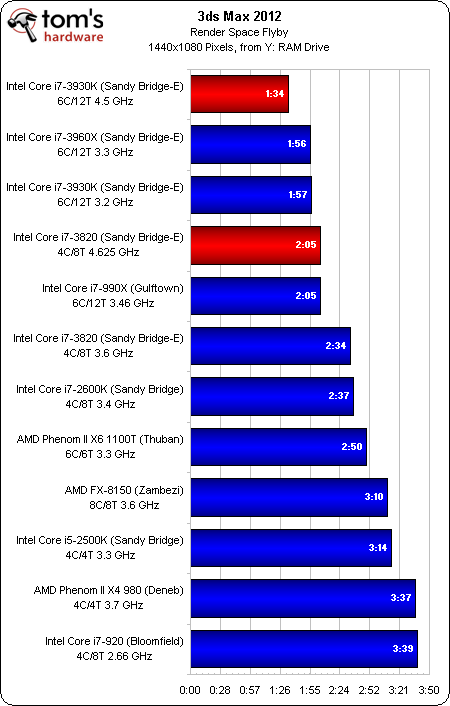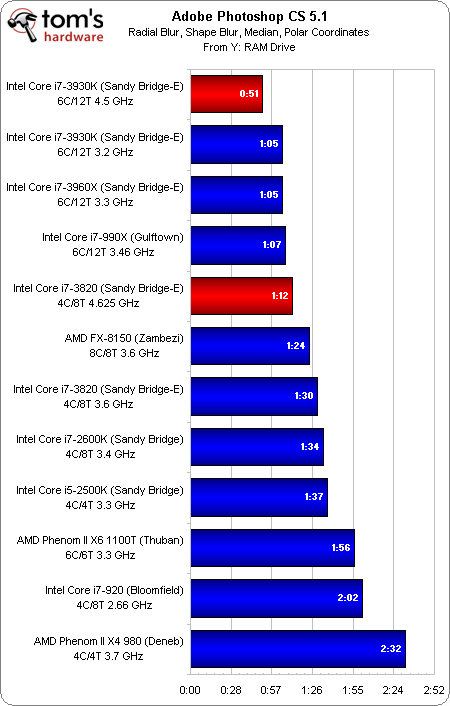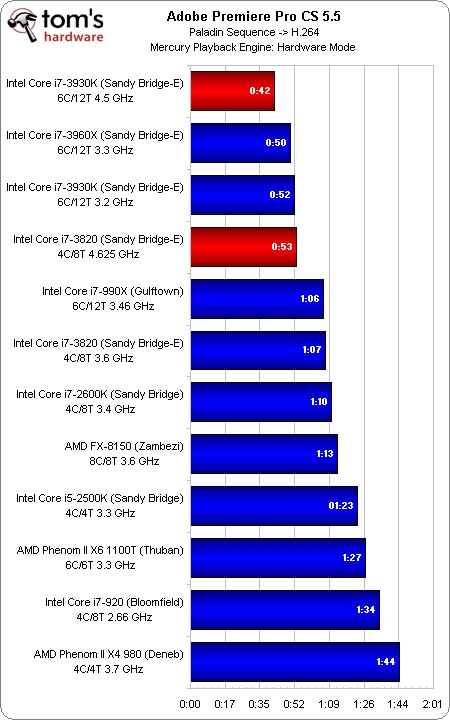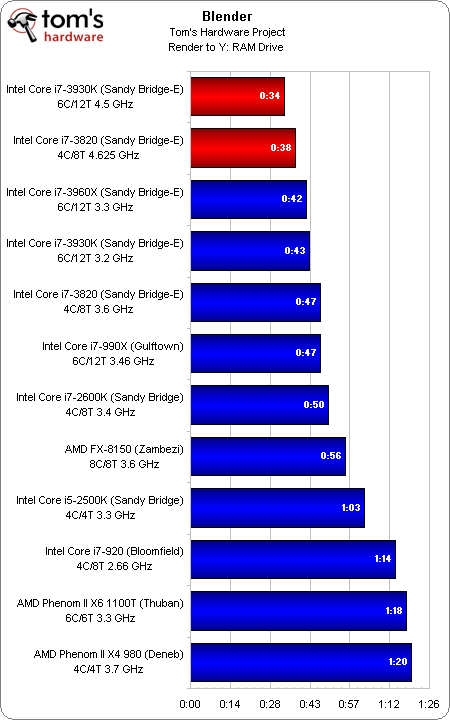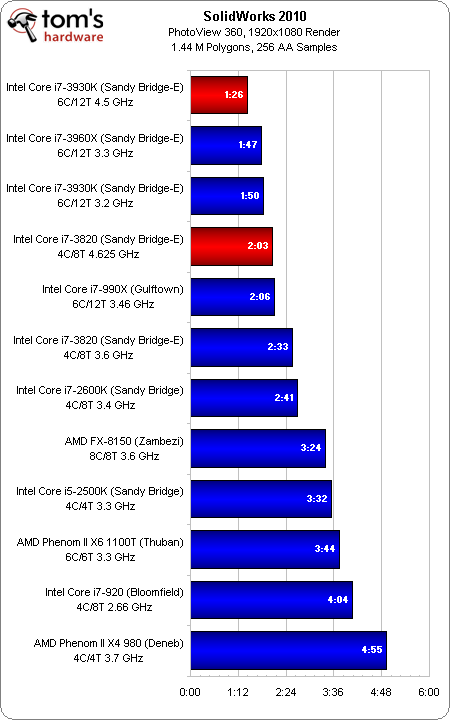Intel Core i7-3930K And Core i7-3820: Sandy Bridge-E, Cheaper
Core i7-3960X is undeniably fast. But at more than $1000, it’s hardly an option for most enthusiasts. We got our hands on the Core i7-3930K and Core i7-3820 to gauge their overclocked performance and determine if they’re able to best the flagship part.
Benchmark Results: Content Creation
A pretty easy analysis, 3ds Max 2012 clearly benefits from as many cores as you throw at it. Overclocking is enough to push the 4.625 GHz Core i7-3820 up next to a stock Core i7-990X. However, it’s the 4.5 GHz Core i7-3930K that really redefines performance here.
The one-second difference between Core i7-3930K and -3960X confirms what we originally suspected: there’s little reason to buy the $1000-dollar chip from a stock performance perspective.
In that same vein, a Core i7-3820 really doesn’t seem far enough superior to Core i7-2600K to warrant its more expensive platform.
The same holds true in Photoshop, and all six-core processors outperform their quad-core competition, regardless of architecture or clock rate. An overclocked Core i7-3930K really shines here, and we again see a close finish between the Core i7-3960X and -3930K at their respective stock clocks.
Accelerated by a GeForce GTX 580, this workload doesn’t take nearly as long as it used to. However, the compute muscle leveled against the task by a Core i7-3930K running at 4.5 GHz is enough to cut 10 seconds from the same processor tackling it at its stock speed.
Notoriously memory-hungry, After Effects reminds us that the overclocked machines only include 8 GB of memory, while all of the configurations with blue bars boast 32 GB (except for the X58-based Core i7-920, limited to 24 GB by its triple-channel controller).
If you’re a video editor, this chart should be proof positive that lots of RAM needs to be a priority. After all, it’d be a shame to sink your cash into a $600 CPU, overclock it, and still get outperformed by a $200 Core i5-2500K at its stock settings (but with more memory).
Get Tom's Hardware's best news and in-depth reviews, straight to your inbox.
Though clearly well-threaded, Blender also demonstrates an affinity for the Sandy Bridge architecture running at high frequencies.
A mix of architectural improvements and unadulterated clock rate propel the overclocked Core i7-3930K up ahead of the pack. A stock Core i7-3960X follows, trailed only just slightly by the Core i7-3930K at its default configuration.
The overclocked Core i7-3820 comes in fourth, ahead of the Gulftown-based Core i7-990X. But the fact that a Core i7-3820 at its stock settings falls into sixth place shows that parallelism matters just as much, if not more, than operating frequency.
Current page: Benchmark Results: Content Creation
Prev Page Benchmark Results: Sandra 2011 Next Page Benchmark Results: Productivity-
compton This is a really excellent analysis. Clearly, I must be drinking at the wrong places because I never leave the pub with any hardware nicer than a hangover.Reply -
theuniquegamer So nice overclocking at 4.5ghz. I can expect that the upcoming ivy bridge unlocked series may be stable atleast 4.2 will all 4 cores active. I can't wait till Q2 next year to see benchmarks .Reply -
Dacatak Possible TYPO in the bottom graph for Dirt 3 benchmark.Reply
FX-8150 benchmark with no AA says "68.8" FPS. I think it's more like "48.8". -
JOSHSKORN For gaming (the high end CPU intensive), is there any noticeable difference between the 2500k and the 3960X?Reply -
Dacatak JOSHSKORNFor gaming (the high end CPU intensive), is there any noticeable difference between the 2500k and the 3960X?Reply
If by "noticeable" you mean "perceivable to mere mortals", then no.
If you can in fact notice the difference between 105 vs 110 FPS, then you are a god, and you deserve only the best. -
spunkyddog I bought the i7-3930K with 32GB of DDR3 1600 RAM last week and assembled a couple days ago. I have two Kingston 120GB SSDs in RAID that have been benched on my system at a theoretical 1,100MB/S Read and 1,300MB/S Write. Coming from a Pentium D 3.0GHz, this was like night and day. My renders went from 40minutes to 1minute. I'm not overclocking purely for the fact that this thing's a beast already and I'm doing high-end 3D work using Maya, Photoshop, After Effects, Video, etc. Also - I like the peace and quiet.Reply
Intel did an awesome job with the SBE line - despite the fact that we're missing some wanted/promised features (native support for USB and PCI-Express 3.0. I'm waiting out for the PCI 3.0 cards before I upgrade my graphics... curious if the Asus P9X79 Pro will hold it's promises.
Thanks Chris for reviewing this processor. I felt like I went out on a limb getting this processor over the Extreme, but the $600 was well worth it. -
cangelini spunky,Reply
Glad you're enjoying. You do, actually get PCIe 3.0 support, but no USB 3.0, unfortunately.
Dacatak,
Yup, typo--fixing now! -
sna the only good reason to get X79 is the more ram .. u can get cheap 32G ram system , or go for 64G of ram and enjoy a ram diskReply
it is a good thing -
soccerdocks The Overclocking Sandy Bridge-E On A Budget page states, "With all of that said, 4.5 GHz was rock-solid down at 3.61 V". I'm pretty sure you meant 1.36 V.Reply -
cangelini soccerdocksThe Overclocking Sandy Bridge-E On A Budget page states, "With all of that said, 4.5 GHz was rock-solid down at 3.61 V". I'm pretty sure you meant 1.36 V.Reply
Indeed, fixed! At 3.6 V, we'd have dead Sandy. :)
